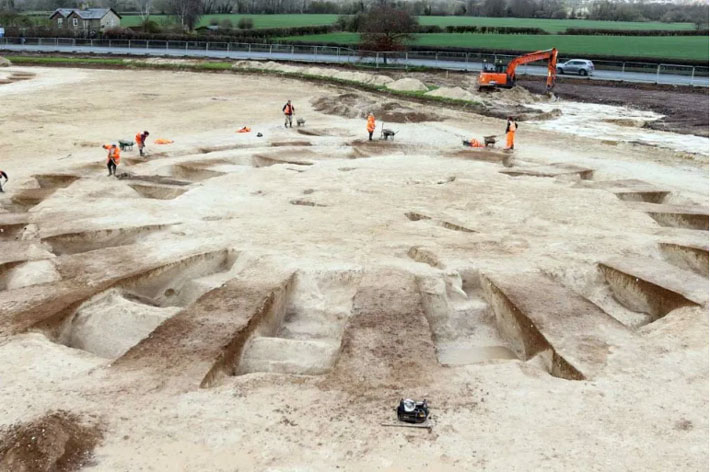 HARNHAM, ENGLAND—According to a Live Science report, more than 20 circular burial mounds estimated to be up to 4,400 years old were uncovered on a chalk hillside about 10 miles from Stonehenge during an investigation conducted ahead of a construction project. The smallest mound measures about 33 feet in diameter, while the largest measures about 165 feet in diameter. Alistair Barclay of Cotswold Archaeology said that the barrows are arranged in pairs or small clusters. Five of the mounds have been fully excavated. One of them had been enclosed with an oval-shaped ditch, which was later replaced with a nearly circular one. This barrow held the remains of adults and children, and may date back to the Neolithic period, Barclay said. The oval ditch was found to have cut through a cache of red deer antlers, a material that was used during the Neolithic period to make tools, ritual items, pins, and combs. Archaeologists will examine these antlers for signs of toolmaking. Other barrows held the distinctive drinking vessels of the Bronze Age Bell Beaker culture. Evidence for the use of the site during the Iron Age and Anglo-Saxon periods was also uncovered. For more on the Bell Beaker culture, go to "Letter from Woodhenge: Stonehenge's Continental Cousin."
HARNHAM, ENGLAND—According to a Live Science report, more than 20 circular burial mounds estimated to be up to 4,400 years old were uncovered on a chalk hillside about 10 miles from Stonehenge during an investigation conducted ahead of a construction project. The smallest mound measures about 33 feet in diameter, while the largest measures about 165 feet in diameter. Alistair Barclay of Cotswold Archaeology said that the barrows are arranged in pairs or small clusters. Five of the mounds have been fully excavated. One of them had been enclosed with an oval-shaped ditch, which was later replaced with a nearly circular one. This barrow held the remains of adults and children, and may date back to the Neolithic period, Barclay said. The oval ditch was found to have cut through a cache of red deer antlers, a material that was used during the Neolithic period to make tools, ritual items, pins, and combs. Archaeologists will examine these antlers for signs of toolmaking. Other barrows held the distinctive drinking vessels of the Bronze Age Bell Beaker culture. Evidence for the use of the site during the Iron Age and Anglo-Saxon periods was also uncovered. For more on the Bell Beaker culture, go to "Letter from Woodhenge: Stonehenge's Continental Cousin."
Ancient Barrows Excavated in Southwest England
